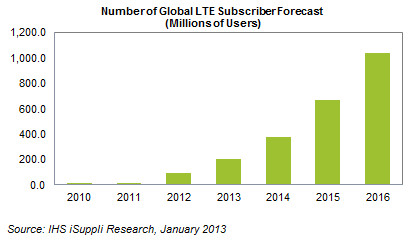
The world’s first publicly available long-term evolution (LTE) service was launched by TeliaSonera in Oslo and Stockholm on December 14, 2009. This year, the 4G wireless standard known is projected to more than double, surpassing the 100 million mark.
The latest figures numbers come from research firm iSuppli. At the end of 2013, four years after its debut, the company projects 4G LTE to reach 198.1 million subscribers worldwide.
The growth trend has been “remarkable” according to iSuppli. The company notes 4G had just 612,000 users in 2010. It surged by a factor of 22 to 13.2 million subscribers in 2011, and then jumping another 599 percent in 2012 to 92.3 million. The majority of early operator activity was concentrated in Europe and Asia, but North America pushed new subscriber numbers in 2011 and 2012.
That’s what we know. Yet iSuppli has estimates going beyond that, saying in 2013 the subscriber base will grow 115 percent over 2012. By 2016, LTE will claim more than 1.0 billion users, equivalent to a five-year compound annual growth rate of 139 percent:
“With LTE emerging as a true global technology standard, its ecosystem now faces both challenges and opportunities,” Wayne Lam, senior analyst for wireless communications at iSuppli’s parent company HIS, said in a statement. “Rapid adoption will drive design innovations, particularly in smartphones, but issues like spectrum fragmentation will also remain an overhang for the LTE industry that requires attention. Overall, however, the LTE space will be less worried about rifts or divisions in technology, and more concerned with laying the foundation for sustained growth across the entire LTE landscape.”
iSuppli says the bulk of growth during the last two years came from smartphone upgrades as data-hungry users looked to satisfy their quench with 4G LTE. As speeds begin to match those of basic broadband, however, we wonder if tablets and other portable PCs will also have a large impact on the growth. Most users could not care less where the Internet is coming from as long as it’s reliable and relatively fast.
Image credit: Tibor Fazakas
Get the TNW newsletter
Get the most important tech news in your inbox each week.





